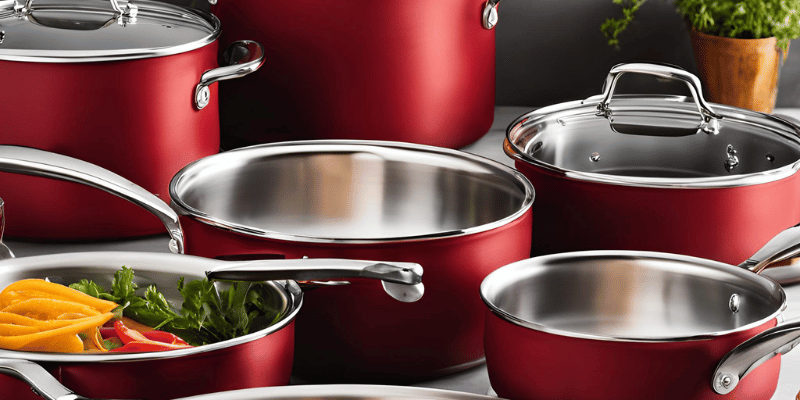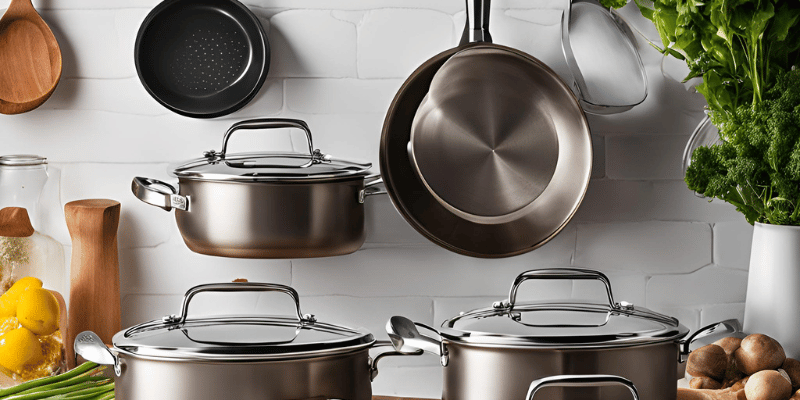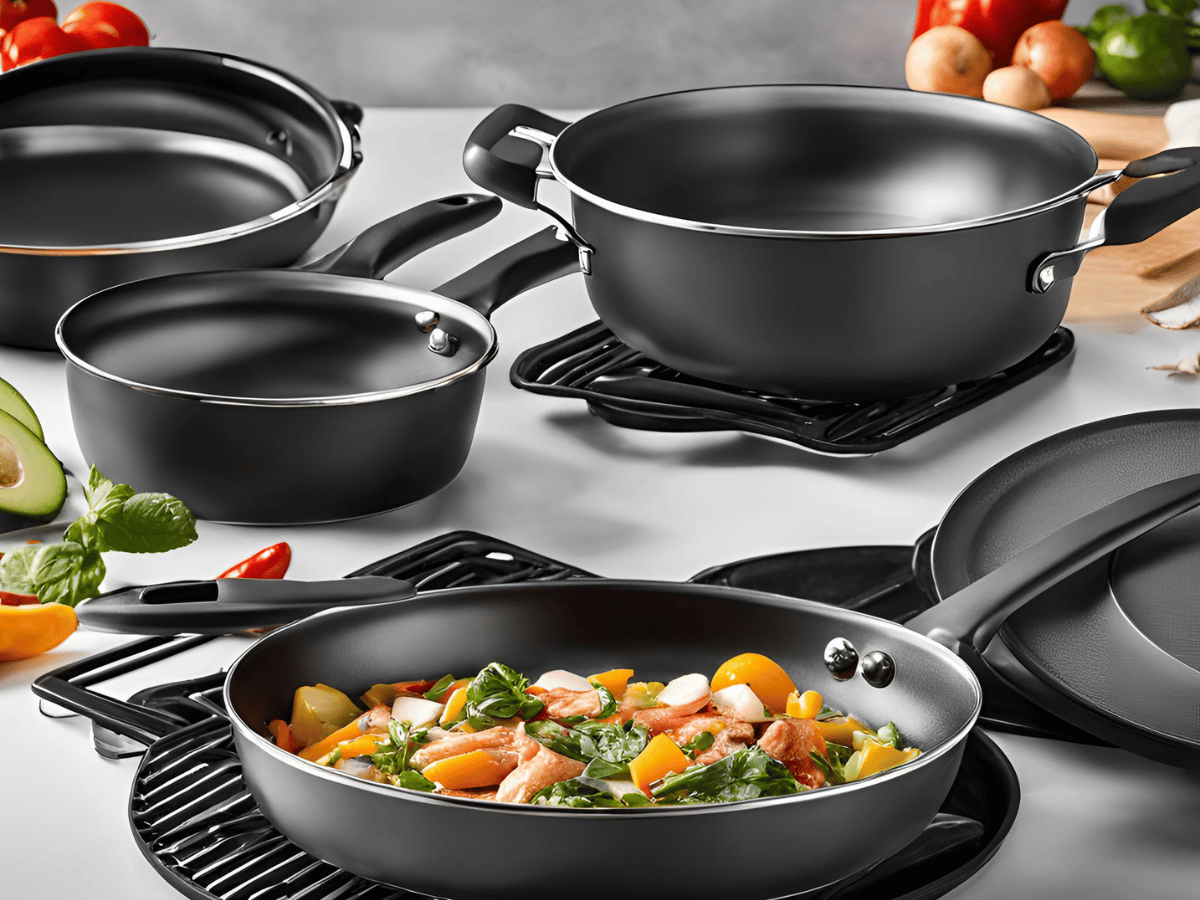Did you know that the pots and pans you use could be adding harmful chemicals to your food? As we learn more about health and wellness, the need for non-toxic cookware sets is growing. People are looking for eco-friendly kitchenware that is free from chemicals to keep their families safe.
In this article, we’ll look at the top five non-toxic cookware sets available. We’ll focus on their features and benefits. These options can change how you cook and make your kitchen healthier.
Understanding Non-Toxic Cookware Options

Choosing the right cookware is crucial for your health and cooking fun. Knowing the difference between toxic and safe options is key. Recent studies show that some cookware contains harmful chemicals, making it important to pick wisely for your kitchen.
What is Toxic Cookware?
Toxic cookware has harmful chemicals like PFAS and PTFE, found in Teflon. These chemicals don’t break down and can harm your health. Studies link them to cancer and other health problems.
Knowing about toxic cookware helps you make better choices.
Importance of Choosing Safe Cookware
Safe cookware is a must for a healthy life. It reduces the risk of harmful chemicals getting into your food. Using non-toxic materials means better health and cooking results.
Choosing non-toxic cookware gives you peace of mind. You can enjoy cooking for your family without worry.
Key Features to Look for in Non-Toxic Cookware
When picking non-toxic cookware, it’s key to know the materials and their safety. Some features can affect your health and how you cook. Look at these areas to choose wisely.
Materials to Avoid
Know what materials to avoid in safe cookware. Stay away from aluminum as it can leak into food and cause health problems. Also, avoid cookware with synthetic nonstick coatings that have harmful chemicals like PFOA and PFOS. These chemicals are bad for your health. Choose materials that keep your food safe.
Understanding Coatings
Check the coatings on cookware to protect your health. Choose brands with safe coatings. Ceramic and glass coatings are great because they don’t leak chemicals. These materials keep your cookware safe for everyday use.
Environmental Impact
Think about the environmental impact of cookware. Look at how materials are sourced and how long they last. Choose eco-friendly options like cast iron and stainless steel. They are durable and safe, and picking them helps reduce waste over time.
| Cookware Material | Health Concerns | Environmental Impact |
|---|---|---|
| Aluminum | Can leach into food, potential health risks | High environmental cost in production |
| PTFE Nonstick | Contains harmful chemicals (PFOA, PFOS) | Not biodegradable, contributes to waste |
| Ceramic | Free of harmful chemicals | Requires careful sourcing; generally sustainable |
| Glass | Non-reactive and safe | Recyclable; low environmental impact |
| Cast Iron | Durable and safe when seasoned properly | Long-lasting; minimal environmental footprint |
| Stainless Steel | Non-reactive and safe for cooking | Recyclable; moderate environmental impact |
Best Non-Toxic Cookware Sets
Finding the best non-toxic cookware sets can make cooking safer and more sustainable. This section highlights top picks for their quality, function, and price. It also offers a detailed comparison to help you pick the right toxin-free set for your kitchen.
Overview of Top Picks
Here are some top choices in sustainable cookware:
- GreenPan Valencia Pro: It has a durable ceramic non-stick coating without PFAS, PFOA, lead, or cadmium. The hard-anodized aluminum ensures even heat distribution.
- Caraway Cookware Set: This set features non-toxic, ceramic-coated surfaces that don’t scratch or stain easily. It’s also lightweight for easy handling.
- GreenPan Chatham: With a modern look and safe materials, this set is great for various cooking methods.
- Lodge Cast Iron Skillets: Known for their excellent heat retention and even cooking, Lodge cast iron is a trusted, toxin-free option that gets better with time.
- Cuisinart Stainless Steel Cookware: This set is durable with a non-reactive surface, making it a versatile choice for a toxin-free cooking set.
Detailed Comparisons of Key Sets
| Cookware Set | Material | Non-Toxic Features | Price Range |
|---|---|---|---|
| GreenPan Valencia Pro | Ceramic Non-stick | PFAS & PFOA Free | $$$ |
| Caraway | Ceramic Coated | Non-toxic & Eco-friendly | $$$ |
| GreenPan Chatham | Ceramic Non-stick | Free of harmful chemicals | $$ |
| Lodge Cast Iron | Cast Iron | Toxin-free & Durable | $$ |
| Cuisinart Stainless Steel | Stainless Steel | Non-reactive surface | $$ |
Understanding the unique features and potential drawbacks of each set helps you choose the best sustainable cookware. This can help you find the perfect set for your cooking style and health goals.
Benefits of Using Non-Toxic Cookware

Choosing non-toxic cookware brings many benefits for your health and the planet. It’s a smart choice for modern kitchens. It helps you stay healthy and supports the environment.
Health Advantages
Non-toxic cookware cuts down on harmful chemicals found in old-style cookware. Stainless steel, cast iron, and ceramic are safer to use. They don’t release toxins, making your meals healthier.
By picking eco-friendly kitchenware, you avoid risks from substances like PFAS and PTFE. This leads to a healthier way of living.
Long-Term Sustainability
Using non-toxic cookware is good for the planet. Durable materials like stainless steel and ceramic reduce kitchen waste. They last longer than regular cookware.
Buying sustainable cookware means you won’t need to replace it often. This supports an eco-friendly lifestyle. Stainless steel and ceramic are great for health and the planet, perfect for those who care about the environment.
| Cookware Type | Health Advantages | Sustainability Features |
|---|---|---|
| Stainless Steel | No leaching of chemicals | Long-lasting, recyclable |
| Cast Iron | naturally non-stick safe at high temperatures> | Durable, can last generations |
| Ceramic | Chemical-free coatings | Biodegradable options available |
| Glass | No chemical reactions with food | Recyclable, minimal waste |
Factors That Influence Your Choice
Choosing non-toxic cookware involves several key factors. Knowing your cooking style and budget helps you pick safe options that fit your needs.
Cooking Style and Preferences
Your cooking style affects the cookware you need. For quick meals, stainless steel or non-stick cookware is great for easy handling. If you love slow cooking or high-heat dishes, cast iron or enameled cookware might be better. It’s important to match your cookware with your cooking habits.
Budget Considerations
Thinking about your budget is crucial when picking non-toxic cookware. Prices vary by brand, material, and features. While top-tier options are great for performance and safety, there are also affordable choices that are just as good. It’s key to balance your spending with your need for safe cookware that fits your cooking style.
| Cookware Type | Price Range | Cooking Style | Material Safety |
|---|---|---|---|
| Stainless Steel | $ | Versatile, everyday cooking | Safe |
| Cast Iron | $$$ | High-heat, slow cooking | Safe |
| Non-Stick | $$ | Quick meals, easy cleanup | Depends on coating |
| Enameled Cast Iron | $$$ | Simmering, baking | Safe |
| Glass Cookware | $ | Baking, stovetop | Safe |
Care and Maintenance for Non-Toxic Cookware
Proper care and maintenance can make non-toxic cookware last longer. It ensures safety and keeps it working well. By cleaning it right and following usage tips, you can use your kitchenware for years.
Cleaning Tips
For cleaning non-toxic cookware, use gentle methods to keep the coatings safe. Here are some tips for cleaning:
- Avoid abrasive sponges or scrubbers that can scratch surfaces.
- Use warm, soapy water for hand washing, especially for ceramic and cast iron.
- For stuck-on food, soak the cookware before scrubbing to loosen residue.
- Always dry thoroughly to prevent moisture buildup and rust, especially on cast iron.
Proper Usage Guidelines
Following the right usage guidelines is key to keeping non-toxic cookware in great shape. Here are some tips:
- Cook at recommended temperatures, avoiding extremely high heat.
- Use utensils made from wood or silicone to prevent scratches on non-stick surfaces.
- Allow cookware to cool before washing to avoid warping.
- Store cookware carefully to prevent stacking damage, especially for non-stick items.
Conclusion
Looking for the best non-toxic cookware sets is now key as we learn more about health risks from old cookware. Choosing safe cookware makes cooking better and keeps us healthy and green.
There are many options out there, each with its own benefits for different cooking needs and budgets. These safe cooking tools let us cook with confidence and support a green lifestyle. Switching to non-toxic cookware means healthier meals and a cleaner planet for all of us.
Choosing wisely about cookware today can really change our health and help the environment. Going for sustainable cookware is more than a trend; it’s a promise to live better and protect our Earth.
FAQ
What are best non-toxic cookware sets made from?
The top non-toxic cookware sets come from materials like stainless steel, ceramic, cast iron, and glass. These materials don’t have harmful chemicals like PFAS or PTFE. So, they’re safer for cooking.
Why should I choose eco-friendly kitchenware?
Eco-friendly kitchenware cuts down on toxic substances and supports green practices. These items are often more durable. This means they last longer, reducing waste and the harm to the environment from making them.
What are the health advantages of using chemical-free pots and pans?
Chemical-free cookware lowers the risk of health problems from traditional cookware. It makes cooking healthier and can make your cooking better.
How do I maintain my non-toxic cookware?
Keep your non-toxic cookware clean by avoiding harsh cleaners and following the maker’s cleaning advice. Use the right utensils and clean it regularly. This keeps your eco-friendly kitchenware in good shape.
Can I use metal utensils on non-toxic cookware?
It depends on the cookware type. Stainless steel and cast iron can take metal utensils. But, many ceramic or nonstick surfaces need silicone, wood, or plastic utensils to prevent scratches and damage.
What should I consider when choosing non-toxic cookware?
Think about your cooking style, what material you like, your budget, and the cookware’s features. Pick cookware that’s safe, meets your needs, and doesn’t compromise on performance.
Are all non-stick coatings harmful?
No, not all non-stick coatings are bad. Old ones with PFAS or PTFE are harmful. Look for safe options like ceramic nonstick coatings that don’t release harmful chemicals.
Source Links
- Sick of Trashing Your Nonstick Pans? We Tested the Best Non-Toxic Cookware Sets – https://www.allrecipes.com/longform/best-non-toxic-cookware/
- Say No to “Teflon Flu” — Here’s Our Favorite Non-Toxic Cookware – https://www.foodandwine.com/lifestyle/kitchen/best-non-toxic-cookware
- Discover the top 7 non-toxic cookware picks for 2024 with Organic Authority. Cook safely and healthily with our expert-approved selections! #HealthyCooking #NonToxicCookware – https://www.organicauthority.com/organic-food-recipes/non-toxic-cookware-brands-to-keep-chemicals-out-of-your-food
